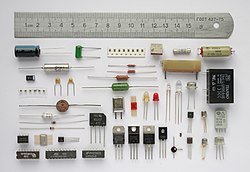Elektronika (from Greek Ηλεκτρόνιο — an electron) — science about interaction of electrons with electromagnetic fields and methods of creation of electronic devices and devices for transformation of electromagnetic energy, generally for reception, transfer, processing and information storage.
History
Emergence of electronics was preceded by the radio invention. As radio transmitters found at once application (first of all by the ships and in military science), for it was required them the element base, was engaged in creation and which studying electronics. The element base of the first generation was based on electron tubes. Respectively vacuum electronics has development. Its development was promoted also by the invention of television and a radar which found broad application during World War II.
But electron tubes possessed essential shortcomings. It first of all the big sizes and high power consumption (that was critical for portable devices). Therefore solid-state electronics started developing, and as element base began to apply diodes and transistors.
Further development of electronics is connected with emergence of computers. The computers based on transistors, differed the big sizes and power consumption, and also low reliability (because of a large number of details). Microassemblies, and then and chips started being applied to the solution of these problems. The number of elements of chips gradually increased, microprocessors began to appear. Now development of electronics is promoted also by emergence of cellular communication, and also various wireless devices, navigators, communicators, tablets, etc.
In development of electronics it is possible to consider as the main milestones:
inventions A.S. Popov of radio (on May 7, 1895), and beginning of use of radio receivers,
invention Li de Forestom of the lamp triode, first intensifying element,
use of a semiconductor element by Losev for strengthening and generation of electric signals,
development of solid-state electronics,
use of conduction and semiconductor elements (Ioffe, Schottky's work),
the invention in 1947 of the transistor (William Shokli, John Bardin and Walter Bratteyn),
creation of an integrated chip and subsequent development of microelectronics, main area of modern electronics.
Electronics areas
It is possible to distinguish the following areas of electronics:
physics (a microcosm, semiconductors, electromagnetic waves, magnetism, an electric current, etc.) — area of science in which the processes happening to loaded particles are studied,
consumer electronics — household electronic appliances and devices in which electric tension, an electric current, electric field or electromagnetic waves is used. (For example TV, mobile phone, iron, bulb, electric stove. etc.).
Power development, transportation and electricity consumption, electrodevices of high power (for example electric motor, electric lamp, power plant), electric system of heating, power line.
Microelectronics - electronic devices in which as active elements chips are used:
optoelectronics - devices in which the electric current and streams of photons are used,
sound - video equipment - devices of strengthening and transformation of a sound and video of images,
digital microelectronics - devices on microprocessors or logical chips. For example: electronic calculator, computer, digital TV, mobile phone, printer, robot, control panel industrial equipment, automobiles, both other household and industrial devices.
The electronic device can include the most different materials and Wednesdays where there is a processing of an electric signal to use of different physical processes. But in any device surely there is an electric chain.
Many scientific disciplines of technical colleges are devoted to studying of various aspects of electronics.
No comments:
Post a Comment